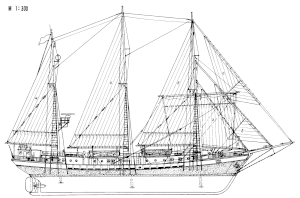Zarya (non-magnetic ship)
Zarya (Russian: Заря, The Sunrise) was a sailing-motor schooner built in 1952, and since 1953 used by the USSR Academy of Sciences to study Earth's magnetic field.
 | |
| History | |
|---|---|
| Name: | Zarya |
| Operator: | USSR Academy of Sciences |
| Builder: | Oy Laivateollisuus Ab, Turku, Finland[1] |
| Launched: | 1952[1] |
| Homeport: | Murmansk[1] |
| Status: | Unknown |
| General characteristics | |
| Type: | Three-masted gaff-rigged schooner[2] |
| Displacement: | 600 long tons (610 t) full load[1] |
| Length: | 52.56 m (172 ft 5 in)[1] |
| Beam: | 8.97 m (29 ft 5 in)[1] |
| Draught: | 3.38 m (11 ft 1 in)[1] |
| Propulsion: | 1 × 300 bhp (224 kW) diesel engine, 1 shaft[1] |
| Speed: | 8 knots (15 km/h; 9.2 mph)[1] |
| Crew: | 35 + 10 mission crew[1] |
After the Continuation War Finland was ordered by the USSR to provide 50 wooden sailing-motor fishing schooners as reparations. One of them was taken, and in 1952 modified, into a low magnetic research vessel named Zarya. Since 1953 the ship was used to measure the magnetic field of the Earth. She participated in the International Geophysical Year in 1957–1958.[3]
In 1976 a rupes on planet Mercury was named after the ship.[4]
See also
References
- "World Navies Today: Russian Civilian Scientific & Support Vessels". hazegray.org. Retrieved 10 September 2010.
- "National Institute for Sea Training (NIST)". kohkun.go.jp. Archived from the original on 28 January 2010. Retrieved 10 September 2010.
- "Eve of International Geophysical Year- British Pathe". britishpathe.com. Retrieved 10 September 2010.
- "Zarya Rupes on Mercury". planetarynames.wr.usgs.gov. Retrieved 10 September 2010.
External links
| Wikimedia Commons has media related to Zarya (ship, 1952). |
- History of Zarya from one of its crewmen (in russian)
- History of Russian research fleet formation
- Photo of Zarya at Odessa in 1959 from LIFE
- Photo of Russian non-magnetic oceanographic research vessel ZARJA (or ZARYA) in Antwerp July 1983
This article is issued from Wikipedia. The text is licensed under Creative Commons - Attribution - Sharealike. Additional terms may apply for the media files.